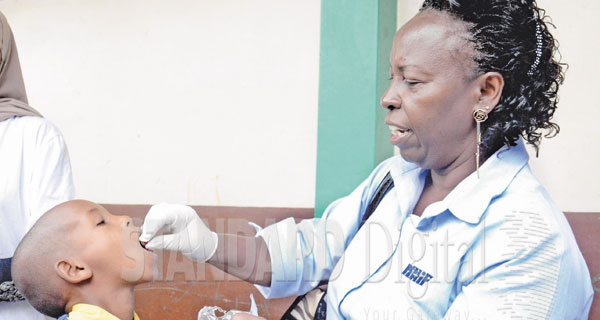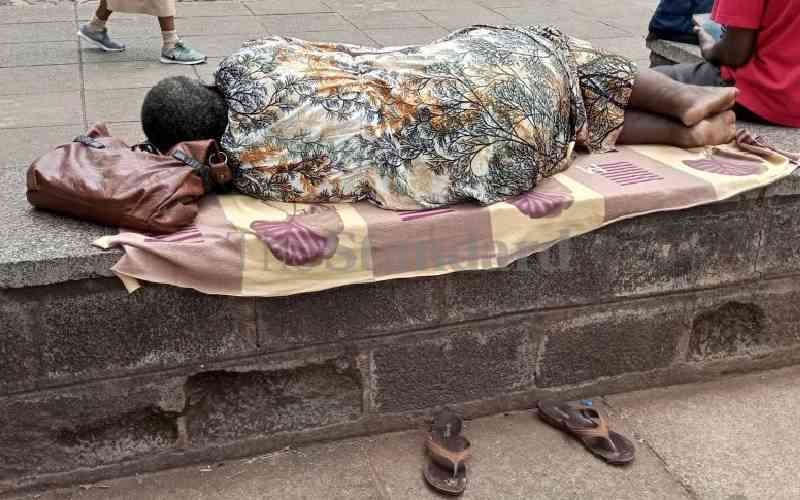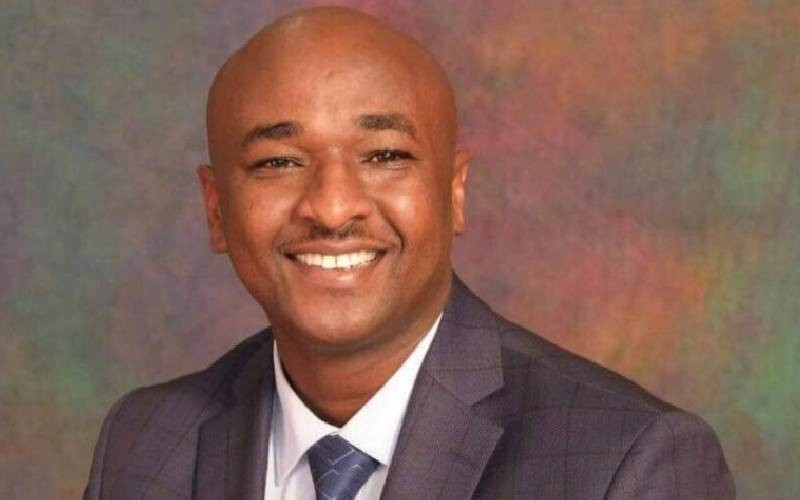 |
|
Elizabeth Kimani of National Hospital Insurance Fund, Ruaraka branch, gives a deworming tablet to Collins Gitau, a pupil at Ndururumo Primary School in Huruma. [PHOTO: FILE/STANDARD] |
By DANN OKOTH
KENYA: Could lack of sufficient medical personnel and equipment at the Kenyatta National Hospital (KNH) be responsible for the reproachable patient care at the facility?
And is this the problem of KNH as an institution or is it a manifestation of the general rot in the country’s healthcare system?
I visit Ward Seven, which is on the seventh floor of the facility’s main building. After about six hours of cat-and-mouse games with guards (security is very tight at the facility and perhaps the only thing you cannot fault KNH about) I gain entry into the ward—on the third evening of the three-night-vigil.
It is past midnight and I finally sneak into Ward Seven ‘B’ after sidestepping a nurse and a gentleman in a white overall with a stethoscope hanging around his neck.
I know I have to be quick because no visitors are allowed in the wards at this time. The silence in the ward is palpable. But I also notice that the room is overcrowded, with at least two patients sharing a bed. The ward was designed to house 35 patients but it now hosts more than 50.
I approach a man on a bed in the middle row and strike a conversation. He is a bit suspicious at first but opens up after seeing my bag of goodies.
He is sick with malaria, he tells me, but I suspect he could be down with anything ranging from malaria to Aids and tuberculosis. And he is sharing a bed with another patient. He narrates how the wards get lonely after nightfall—by lonely he means few or none of the medical staff are available to attend to them.
Nurses and interns
“There are usually two rounds, with one at 7.30pm and another at 11.30pm conducted by doctors. But that is the last time we see the doctors, the ward is left in the hands of nurses and interns,” he says.
His statement confirms what a nurse at the hospital had told me earlier that the medical ward is often left in the hands of interns and nurses during the night. “The doctors often leave for home after conducting their final rounds with firm instructions they should be called in the event of any emergency,” she said.
The doctor-patient ratio is one doctor to 17,000 of the population as opposed to the recommended one doctor for every 1000 patients by the World Health Organisation.
Improvement in the sector has been frustrated by systemic funding gaps, including lingering poor budgetary allocations. The last budget to health was Sh84 billion, which equals 5.9 per cent of the national Budget as opposed to the 15 per cent envisioned by the Abuja Declaration.
About Sh2 billion goes to medicines and medical supplies against the needed Sh15.94 billion. Malaria, TB and HIV programmes are donor reliant to as much as 95 per cent.
But the apathy in personnel seems to be more worrying. According to Kenya Medical Practitioners, Pharmacists and Dentists Union (KMPPDU) chairman Dr Victor Ngani, Kenya has lost 51 per cent of her doctors to countries offering better terms.
Stay informed. Subscribe to our newsletter
“It is difficult to tell exactly but in 1999, Kenya had about 3,000 doctors in public service. From 1999, we have trained between 250 and 700 doctors consistently per year (locally and abroad). In November 2011, despite the start value of 3,000, and the improved annual training rates, the number of doctors in the public sector was 2,334. Where did all the rest go?” he poses. In November 2011, it was estimated up 80 per cent of doctors would leave government by the third year of service to go to the private sector, with Botswana and South Africa being the biggest beneficiaries. Others go to Britain, US, Australia, Canada and France.
It is estimated the total cost of educating a doctor from primary school to university is Sh5 million; and for every doctor who emigrates, the country loses about Sh1.5 million worth of returns from investment.
[email protected]
 The Standard Group Plc is a
multi-media organization with investments in media platforms spanning newspaper
print operations, television, radio broadcasting, digital and online services. The
Standard Group is recognized as a leading multi-media house in Kenya with a key
influence in matters of national and international interest.
The Standard Group Plc is a
multi-media organization with investments in media platforms spanning newspaper
print operations, television, radio broadcasting, digital and online services. The
Standard Group is recognized as a leading multi-media house in Kenya with a key
influence in matters of national and international interest.
 The Standard Group Plc is a
multi-media organization with investments in media platforms spanning newspaper
print operations, television, radio broadcasting, digital and online services. The
Standard Group is recognized as a leading multi-media house in Kenya with a key
influence in matters of national and international interest.
The Standard Group Plc is a
multi-media organization with investments in media platforms spanning newspaper
print operations, television, radio broadcasting, digital and online services. The
Standard Group is recognized as a leading multi-media house in Kenya with a key
influence in matters of national and international interest.









